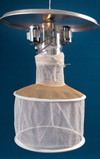Continue to check our website for further updates on when we will reopen. When the museum reopens, all visitors will need to make reservations at least a week in advance. Walk-in visits are no longer permitted.
CDC History Collection
The David J. Sencer CDC Museum (CDCM) Collection has existed since 1995 to advance historical understanding of CDC’s rich heritage through materials reflecting the history and science of CDC. The Collection is utilized for exhibitions, educational programs, and research. Through preserving records of significant CDC achievements of the past and the present, CDCM explores the past to enhance present understanding of public health and CDC. The museum actively collects, catalogs, preserves, conserves, and stores three-dimensional objects, equipment, photographs, papers, films, documents, audio recordings, oral histories, and ephemera. There are more than 20,000 items in the collection.

Nigeria. Credit: The Carter Center/E. Staub, The Global Health Chronicles
We keep CDC’s history, and serve not only to tell the stories of our past, but protect items that would otherwise be lost.
Explore the collection
The David J. Sencer CDC Museum’s Collection is available to scholars, students, historians, employees, and researchers. Please direct any questions regarding our collections to the Historic Collections Manager at history@cdc.gov.
One of the results of having such an extensive collection is The Global Health Chronicles, launched in collaboration with Emory University’s Libraries, Global Health Institute, and Rollins School of Public Health. The web site is a series of “Chronicles,” each dealing with a different subject. Eventually we hope that it will become a digital history of global disease prevention, with CDC as a key agent of prevention.
Leave a legacy
Contact CDCM today at history@cdc.gov to donate your artifacts.

Mosquito Light Trap
CO2-Baited Trap
This light trap was developed by W. Daniel Sudia and Roy Chamberlain in 1960 to sample host-seeking female adult mosquitoes. Gift of Andy Comer.